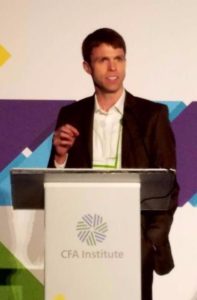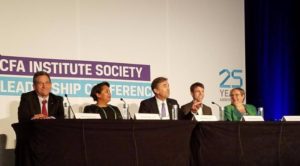
I just returned from the 2017 CFA Institute Society Leadership Conference, held this year in Philadelphia. I have now attended seven Institute conferences for Society leaders over the past six years, covering both Society Leadership and America’s Regional conferences. It was also likely my last Society Leadership Conference, as I will finish my term as President of CFA Society Minnesota in August.
The Society Leadership Conference is attended by 2-3 representatives from all of the CFA Societies around the world. It is one of my favorite things I get to do as a Society rep, as I love mingling with industry practitioners from Ireland, Vietnam, Argentina, Vancouver, Qatar, Germany, Australia, Shenzhen and dozens more countries and cities from around the world. Regardless of where we call home we have the shared experience of having taken (and passed) all three CFA exams, in English, on the first Saturday in June over the course of 3, 4 or 10 years.
As I have mentioned in prior letters these conferences get better every year. The theme this year was “The Power of the Personal,” with many of the sessions focusing not just on Institute and Society initiatives but on personal and professional development. These sessions included training on delivering media interviews, improving presentation skills, and how to use mindfulness to improve health and job performance. It was a great combination of information and training for managing the local Society as well as improving my own professional skills.
During the plenary session on Fr iday morning I was able to participate in a debate on the future of the profession. Besides myself, the debate included Society leaders from New Zealand, France and South Africa. The moderator was from Turkey, making it a truly global panel. The exact motion we debated was “This house believes that the investment profession as we know it will be obsolete in 10 years.” I represented the opposition, arguing that the profession will not be obsolete at that time. We had a lot of fun during the debate and it was a highlight of the conference for many attendees. It definitely spurred lots of interesting conversation afterward.
iday morning I was able to participate in a debate on the future of the profession. Besides myself, the debate included Society leaders from New Zealand, France and South Africa. The moderator was from Turkey, making it a truly global panel. The exact motion we debated was “This house believes that the investment profession as we know it will be obsolete in 10 years.” I represented the opposition, arguing that the profession will not be obsolete at that time. We had a lot of fun during the debate and it was a highlight of the conference for many attendees. It definitely spurred lots of interesting conversation afterward.
Here is a summary of my argument. Despite the headlines of job losses in the industry, the flows from active to passive and the threat of artificial intelligence on analyst and research jobs, I believe that the investment profession’s core purposes of helping create wealth (by mobilizing capital to productive uses for future growth) and managing client savings, spending and financial risk through time will still be needed 10 years from now, and will still require human ingenuity and discernment.
The only risk is that if the profession isn’t trusted and transparent parts of the industry may be killed off by regulation, technology and disintermediation. But if we work together to align incentives between asset owners, asset managers, savers and beneficiaries the profession as we know it will be even stronger 10 years from now. We will continue to gain more tools than ever to fulfill our duties as investment professionals, tools we should embrace. And if we use those tools properly I expect that the demand for our services will only grow over time, not become obsolete, and will also help create a better society.
Have a differing view, or want to share your opinion on this motion? Please post a comment below. I look forward to reading your thoughts and ideas on the future of the investment profession.
Joshua M. Howard, CFA
President, CFA Society Minnesota





